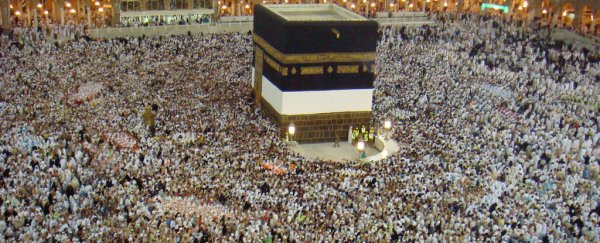Tragic incidents like the crowd crush that killed more than 700 people during the Hajj pilgrimage in Saudi Arabia last week are terrible accidents, but they don't play out the way we might think, says one expert on crowd behaviour.
The popular conception of a dangerously overcrowded throng of people beginning to panic and flee is not what actually occurs in these sorts of incidents, according to Stephen Reicher, a professor of social psychology at the University of St. Andrews in Scotland.
"The conventional way of thinking about crowd psychology is quite simply wrong," Reicher told Monte Morin of the Los Angeles Times. "There is talk of 'stampede' and of 'panic'. But stampede suggests that people cause havoc while running away. In disasters like these, the problem is generally that people can't move at all, let alone run away."
Instead of a mad scramble for a potential exit, the calamity begins much more simply and less dramatically. All it takes is for a few people in a moving crowd to stumble and fall over, and the massive throng behind them keeps pushing forward because they're unaware of the pile-up that's occurred up ahead. "That is where the crushing arises," Reicher says.
In these sorts of incidents, about half of the deaths result from asphyxiation, as people become simply so squashed together that they can no longer move enough to breathe.
So when does a crowded-but-safe mass of people become an overcrowded-and-dangerous mass of people? Generally, the answer is when the crowd density hits about four people for every square metre. At this level of density, physical contact between crowd members starts to create waves of pushing that can quickly become dangerous. "Waves go backwards and forwards in a potentially critical manner," Reicher says.
An eyewitness account from last week's accident backs this hypothesis up – and it's undeniably more affecting when delivered from someone with first-hand knowledge.
"I saw someone trip over someone in a wheelchair and several people tripping over him. People were climbing over one another just to breathe," Abdullah Lotfy, one of the survivors of the tragedy, told the Associated Press. "It was like a wave. You go forward and suddenly you go back."
The Hajj has a long history of tragic accidents due to overcrowding, with more than 2 million people making the pilgrimage to Mecca each year. The worst incident occurred in 1990, when ventilation problems in a tunnel led to surging that claimed more than 1,400 lives.
Although it's always risky to become immersed in a dense mass of people, a sense of purpose and solidarity among crowd members can in some instances alleviate the problems caused by overcrowding.
"Crowd psychology can actually make things better, leading people to coordinate better and even help each other in disasters," says Reicher. "The only danger is that people who feel part of the crowd may have a false sense of security in overly crowded spaces."
